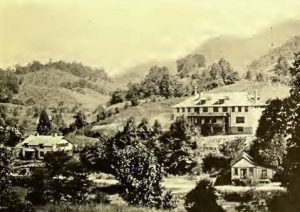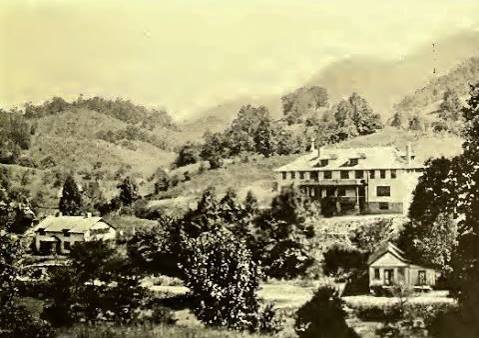Hi, Folks!
As promised, the article this week deals with how Frances Louisa Goodrich managed to get a hospital built in the Whiterock Community of northern Madison County, North Carolina.
To be honest, I wasn’t entirely sure how I wanted to go about doing this. It’s as much about the characters who helped Whiterock Hospital come to fruition as it is about Frances Goodrich but it’s only the cliff notes version all the same.
 As I revealed last week, my wife Lou Anne and I live on the grounds of the old Presbyterian Mission, which was bought by my late in-laws, Ray & Mary Wallin Tweed, after they had been married a few years following Ray’s return from WWII and the subsequent completion of his college education.
As I revealed last week, my wife Lou Anne and I live on the grounds of the old Presbyterian Mission, which was bought by my late in-laws, Ray & Mary Wallin Tweed, after they had been married a few years following Ray’s return from WWII and the subsequent completion of his college education.
As it goes with the purchase of any home, things are often left behind. In this particular case, those items included invaluable documents on the development of the hospital and how it came to be; booklets and pamphlets with photos. Writings from multiple sources.
Those sources have helped me piece together many of the actual facts concerning the origins of the hospital, versus many of the associated legends and folklore circulating in the community. The hardest part about this isn’t going to be in writing the story but trying to decide which photos to include.
Frances Goodrich already had Allanstand Cottage Industries in full swing as a way for mountain women to provide for their families by 1910.
However, Miss Goodrich had been in Madison County for almost fifteen years by this time. She had become close to many of the people in the community and had seen firsthand their needs. Soon, she began wanting to do more than organize and run the Cottage Industries business.
She saw firsthand that there was a severe lack of medical care within the community. Simple injuries, by today’s standards, were often fatal due to infection. The overall mortality rate was horrific, especially for women and children.
The nearest doctor was fifteen miles away in Marshall, while the nearest hospital was twenty-five miles away in Greeneville, Tennessee. Both distances almost certainly provided insurmountable odds in life or death situations requiring immediate medical care.
Frances Louisa Goodrich decided she wanted a hospital built for the people within the community. She presented her ideas and wish to Board of Home Missions of The Presbyterian Church in New York City.
They scoffed at the idea but Miss Goodrich, all five feet of her, would not be deterred.
 Somehow, someway, she managed to persuade Dr. George H. Packard into leaving his successful practice at Packard Private Hospital in Medford, Massachusetts just outside of Boston and head for Madison County, North Carolina. This may have proven an easier discussion for Dr. Packard with his wife, Miranda, as she had been a Presbyterian Missionary in China during The Boxer Rebellion.
Somehow, someway, she managed to persuade Dr. George H. Packard into leaving his successful practice at Packard Private Hospital in Medford, Massachusetts just outside of Boston and head for Madison County, North Carolina. This may have proven an easier discussion for Dr. Packard with his wife, Miranda, as she had been a Presbyterian Missionary in China during The Boxer Rebellion.
Dr. and Mrs. Packard arrived to Madison County sometime in 1914, settling in the Allegheny section of Shelton Laurel, better known around here as “Up the Creek”. There is even mention of Dr. Packard’s arrival in the November 6, 1914 edition of The News Record, Madison County’s only newspaper which is offered weekly.
Dr. Packard was held with suspicion by locals at first. Ealy “Granny” Banks, who considered herself an “old-timey” mountain doctor, held Dr. Packard and his staff in particular contempt. Granny Banks traditional greeting for Dr. Packard when she would meet him on the road was, quote “Go to Hell”!
Nevertheless, Dr. Packard forged on even in spite of personal loss. He and his wife lost a child after moving to Whiterock despite his mastery of medical knowledge and skill. However, he soon became very popular and beloved within the community.
Nonetheless, the determination and hard work of both Frances Goodrich and Dr. George Packard were still met with denial by The Board of Home Missions when it came to funding the erection of a hospital.
Two events would change all that.
 The first happened when Jimerson Sevier Tweed, older brother of my Great Grandpa Rufus, became ill with appendicitis. Dr. Packard knew that time was of the essence. While Jimerson Tweed laid upon his own dining room table, Dr. Packard performed a full-on appendectomy while friends and neighbors observed through the window. Dr. Packard performed the operation by lamplight no less!
The first happened when Jimerson Sevier Tweed, older brother of my Great Grandpa Rufus, became ill with appendicitis. Dr. Packard knew that time was of the essence. While Jimerson Tweed laid upon his own dining room table, Dr. Packard performed a full-on appendectomy while friends and neighbors observed through the window. Dr. Packard performed the operation by lamplight no less!
At approximately age seventy, Jimerson Tweed made a full recovery. This cemented Dr. Packard’s reputation and place within the community.
Jimerson Tweed and his wife, Polly, would wind up selling property to The Presbyterian Church for a hospital.
The second event which changed everything was due to a Presbyterian Missionary and Author named Anna Benjamin Taft, who visited Madison County in October of 1915, traveling to various Missions throughout the county.
Upon her return to New York City, Miss Taft died on January 8, 1916 at the age of forty-two. I’m not sure what the cause of death was, either from the 1916 Polio epidemic, the “Grip” epidemic which became known to be known as Influenza, or if it was something else.
At any rate, the Anna Benjamin Taft Memorial Hospital Fund was founded. A booklet entitled “Over The Hills And Far Away” was even published, recounting Taft’s visit to Madison County, in memorial.
This fueled the funding for the hospital and the Board of Home Missions had no choice but to honor it, as the funds were raised specifically for a hospital at Whiterock.
Despite its financial origin, this was a stunning triumph for Frances Goodrich!
The hospital was originally set to be built on land sold or given by Fowler Shelton but as I stated above, it was decided to build it at the community’s center at Whiterock on land sold to the Presbyterian Church by Jimerson & Polly C. Tweed.
Jimerson’s granddaughter, the late Ruth Tweed Landers, liked to tell the story of how her grandpa gave the land to the Presbyterian’s but the deed proves that it was sold to the Presbyterian Church at a cost of two hundred dollars.
The Whiterock Hospital was erected, taking its first patient in May of 1919. It was approximately one hundred feet long by fifty feet wide and was three stories high if you included the field stone daylight basement.
In contrast to its environment, the hospital was state of the art, complete with battery powered electricity, an operating room, kitchen, laundry area and provided beds for sixteen people.
Goodrich had retired from teaching the previous year but still worked with the Church, serving as the hospitals Treasurer.
In 1932, however, the hospital went bankrupt, yet another victim of The Great Depression.
Although the funding gave way, some staff stayed here, making the hospital and manse their home while continuing to offer medical services to the community until after WWII.
As I stated last week, Frances Louisa Goodrich died in 1944 at the age of eighty-eight.
These two very short articles only lightly highlight the contributions that Frances Louisa Goodrich made to the Appalachian region of Madison County, North Carolina.
For next week, as my final installment on Frances Goodrich, I would like to offer one of her writings (or two) in my possession which shows just how stark things were around here at that time…….if that’s okay by y’all?
Y’all have a great week!
*NOTE* – 1920 Hospital Photo Credit – Francis R. Bellamy

